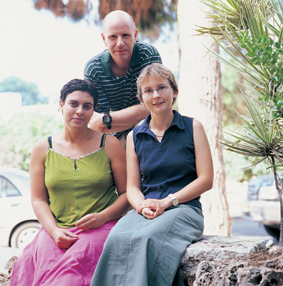Quantum computers might have the ability to work millions of times faster than today’s computers. For this reason, scientists around the world cherish the dream of creating practical quantum computers, even though no one is quite sure the undertaking is really feasible. But this much is already clear: to construct a quantum computer, they must devise a way of storing and processing information that is encoded in quantum bits.
A regular bit is an entity that can exist in one of two states, usually described by the digits zero (0) and one (1). In contrast, a quantum bit can exist simultaneously in many more than two states. Several candidates might perform the function of a quantum bit. One is the electron, which forms the basis of modern electronics. Electronics takes advantage of the electron’s property of carrying an electric charge; but electrons are also characterized by a kind of a spinning motion, or spin. This motion can have two opposite directions. Thus two electrons carrying the same electric charge can differ in the direction of their spins. The differences in spin direction, as well as a unique state called superposition, are likely to provide the basis for quantum computation technology.
Superposition is a quantum phenomenon first described by Erwin Schroedinger, who demonstrated it through a thought experiment known as "Schroedinger’s cat." In this experiment, a cat is placed in a closed box together with a bottle of poison whose cork is connected to a trigger made of radioactive material. When this material decays at some point, the accompanying radiation will activate the trigger, which will then open the bottle and release the poison that will kill the cat. An observer watching the closed box can’t know whether or not the radioactive trigger has already been activated, and therefore cannot be sure whether the cat inside is dead or alive. What, then, is the cat’s real state? According to quantum theory, before the observer opens the box or measures the cat’s condition in any way, the cat exists in a state of superposition: It is simultaneously dead and alive. This is not a trick but a formulation of principle: In quantum theory, an unevaluated cat is truly both dead and alive at the same time. (It’s worth noting that quantum theory is the best proven of all scientific theories.)
Prof. Amir Yacoby of the Weizmann Institute’s Condensed Matter Physics Department and a team headed by Prof. Charles Marcus of Harvard University have recently conducted an experiment showing how the spin of electrons in a state of superposition can be used as a quantum bit. The idea is based on the fact that superposition exists only until someone has observed or measured the system. At the moment of measurement, the "magic" vanishes - the cat can only be either dead or alive; it can no longer exist "in both worlds." The question is: How long can the "magic" last before somebody or something measures it, thereby ending its existence?
In the new experiment, the scientists created systems in which the electrons’ spin was in superposition, and they managed to measure, for the first time ever, the duration of this superposition in a single electron. In other words, they measured how long a situation in which an electron is characterized by spins pointed simultaneously in two directions can last - a situation, that is, which ends the moment something or someone performs a measurement on the electron. To conduct the experiment, the scientists developed a way to measure the spin directions of a single electron inside a "box." Their approach is based on a system that "translates" spin into an electric charge. The position of the charge can be measured by well-known methods, so that the system measures electric charges and derives the spins from these measurements. A report on this research has recently been published in the journal Science.
Essentially, the new approach allows scientists to point a particle’s spin in any desired direction, not only the usual two. This means that the scientists can control the spin, designing different superposition states on demand. Each such superposition can represent different information, making it possible to encode information in quantum systems based on the electrons' spin. That’s a major advance toward developing quantum computers that will be able to perform computational tasks which are difficult for regular computers - such as dismantling a product of two large primes into its original components. The ability to perform such tasks has great practical significance in several areas, including encoding and decoding information.
Prof. Yacoby and his Ph.D. students Merav Dolev and Sandra Foletti are now studying ways of grouping quantum bits, moving them from one location to another, creating logical quantum gates and performing a number of other tasks that may advance the practical application of quantum computers.
Prof. Amir Yacoby's research is supported by the Rosa and Emilio Segre Fund; and the Joseph H. and Belle R. Braun Center for Submicron Research.
